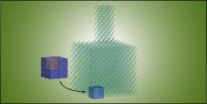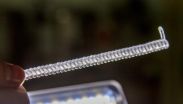(Press-News.org) PHILADELPHIA – Two new smart phone applications may help people detect epileptic seizures and get better stroke treatment, according to two studies released today that will be presented at the American Academy of Neurology's 66th Annual Meeting in Philadelphia, April 26 to May 3, 2014.
In the first study, an epilepsy app was designed to help non-doctors determine if a person is having an epileptic seizure.
"It can often be difficult to determine whether someone is having an epileptic seizure," said study author Victor Patterson, MD, a neurologist from Belfast, UK. "This app will help health professionals evaluate and make the diagnosis, especially when doctors are not available."
To create the app, the researchers asked 67 people questions about their seizures. The most helpful questions/answers for predicting an epileptic seizure were then used to create an app. The app was then tested on 132 people in India and Nepal and the results were compared to the diagnosis from a doctor. The app was informative in 87 percent of people studied and agreed with the doctor's diagnosis in 96 percent of these cases.
For the second study, researchers looked at a stroke app. The app makes it easier and more efficient for doctors to manage care for their acute stroke patients.
"Those who treat acute stroke patients often need to accomplish many tasks simultaneously," said Claude Nguyen, MD, of the University of Pennsylvania Perelman School of Medicine in Philadelphia and a member of the American Academy of Neurology. "Not only do we need to deliver acute therapies such as intravenous tPA both safely and expeditiously, but also evaluate them for clinical trials, and mobilize appropriate resources toward these goals."
Nguyen first formed the idea for the app as a stroke fellow at the University of Texas (UT) Health Science Center at Houston, brainstorming ways to utilize his passion in technology to improve stroke care. He wrote the app on his own time, building features to help with quality improvement, ease communication, and screen for clinical trials. The app is now being used by physicians, nurses, and research support staff at UT.
Both studies were funded by their authors.
INFORMATION:
Learn more about brain disease at http://www.aan.com/patients.
The American Academy of Neurology, an association of more than 27,000 neurologists and neuroscience professionals, is dedicated to promoting the highest quality patient-centered neurologic care. A neurologist is a doctor with specialized training in diagnosing, treating and managing disorders of the brain and nervous system such as Alzheimer's disease, stroke, migraine, multiple sclerosis, brain injury, Parkinson's disease and epilepsy.
For more information about the American Academy of Neurology, visit http://www.aan.com or find us on Facebook, Twitter, Google+ and YouTube.
New apps may help detect seizures, treat strokes
2014-02-20
ELSE PRESS RELEASES FROM THIS DATE:
Western University primatologist teams with international group to save lemurs
2014-02-20
Lemurs, the most endangered mammal group on Earth, represent more than 20 per cent of the world's primates. Native only to Madagascar, more than 90 percent of the species are threatened with extinction.
A Western University primatologist has teamed with 18 lemur conservationists and researchers, many of whom are from Madagascar or have been working there for decades, to devise an action plan to save Madagascar's 101 lemur species. The action plan contains strategies for 30 different priority sites for lemur conservation and aims to help raise funds for individual projects. ...
Vibration energy the secret to self-powered electronics
2014-02-20
MADISON — A multi-university team of engineers has developed what could be a promising solution for charging smartphone batteries on the go — without the need for an electrical cord.
Incorporated directly into a cell phone housing, the team's nanogenerator could harvest and convert vibration energy from a surface, such as the passenger seat of a moving vehicle, into power for the phone. "We believe this development could be a new solution for creating self-charged personal electronics," says Xudong Wang, an assistant professor of materials science and engineering at the ...
Study in mice raises question: Could PTSD involve immune response to stress?
2014-02-20
COLUMBUS, Ohio – Chronic stress that produces inflammation and anxiety in mice appears to prime their immune systems for a prolonged fight, causing the animals to have an excessive reaction to a single acute stressor weeks later, new research suggests.
After the mice recovered from the effects of chronic stress, a single stressful event 24 days later quickly returned them to a chronically stressed state in biological and behavioral terms. Mice that had not experienced the chronic stress were unaffected by the single acute stressor.
The study further showed that immune ...
Nanoscale pillars could radically improve conversion of heat to electricity
2014-02-20
University of Colorado Boulder scientists have found a creative way to radically improve thermoelectric materials, a finding that could one day lead to the development of improved solar panels, more energy-efficient cooling equipment, and even the creation of new devices that could turn the vast amounts of heat wasted at power plants into more electricity.
The technique—building an array of tiny pillars on top of a sheet of thermoelectric material—represents an entirely new way of attacking a century-old problem, said Mahmoud Hussein, an assistant professor of aerospace ...
Developing countries face 'leading medical scourge of developed countries'
2014-02-20
(Garrison, NY) Chronic illness, already a major and expensive problem in developed countries, is rapidly increasing in developing countries, adding to the longstanding burden caused by high rates of infectious diseases. However, poor countries will not be able to afford the costly medical technologies that wealthy countries use to treat chronic conditions, including heart disease, stroke, cancer, pulmonary disease, and diabetes, writes Daniel Callahan, cofounder of The Hastings Center.
Callahan examines this trend and concludes that it calls for a new, more economically ...
Long-term daily multivitamin supplement use decreases cataract risk in men
2014-02-20
SAN FRANCISCO – Feb. 20, 2014 – Long-term daily multivitamin supplement use may lower cataract risk in men, according to a study of nearly 15,000 male physicians published this month in Ophthalmology, the journal of the American Academy of Ophthalmology.
Past observational studies have indicated a relationship between nutritional supplement use and eye health. However, randomized trial data on the effects of long-term multivitamin supplement use and risk of eye diseases are limited and, in some cases, non-existent. To address this, researchers based at Brigham and Women's ...
Extreme weather decides distribution of insects
2014-02-20
As climate change is progressing, the temperature of our planet increases. This is particularly important for the large group of animals that are cold-blooded (ectothermic), including insects. Their body temperature is ultimately determined by the ambient temperature, and the same therefore applies to the speed and efficiency of their vital biological processes.
But is it changes in average temperature or frequency of extreme temperature conditions that have the greatest impact on species distribution? This was the questions that a group of Danish and Australian researchers ...
UT Dallas-led team makes powerful muscles from fishing line and sewing thread
2014-02-20
An international team led by The University of Texas at Dallas has discovered that ordinary fishing line and sewing thread can be cheaply converted to powerful artificial muscles.
The new muscles can lift a hundred times more weight and generate a hundred times higher mechanical power than the same length and weight of human muscle. Per weight, they can generate 7.1 horsepower per kilogram, about the same mechanical power as a jet engine.
In a paper published Feb. 21 in the journal Science, researchers explain that the powerful muscles are produced by twisting and ...
Bioengineered growth factors lead to better wound healing
2014-02-20
When we are wounded, our bodies naturally begin a process of repair of the damaged tissue. This process is mediated by biological molecules called growth factors, which are proteins that occur naturally in our cells and guide processes ranging from embryonic development to healing. Given their regenerative role in the body, growth factors have been investigated for use in drugs but with limited success. Publishing in Science, an EPFL group has used bioengineering to significantly improve the efficacy of clinical growth factors in the context of soft tissue and bone repair, ...
Previous rapid thinning of Pine Island Glacier sheds light on future Antarctic ice loss
2014-02-20
New research, published this week in Science, suggests that the largest single contributor to global sea level rise, a glacier of the West Antarctic Ice Sheet, may continue thinning for decades to come. Geologists from the UK, USA and Germany found that Pine Island Glacier (PIG), which is rapidly accelerating, thinning and retreating, has thinned rapidly before. The team say their findings demonstrate the potential for current ice loss to continue for several decades yet.
Their findings reveal that 8000 years ago the glacier thinned as fast as it has in recent decades, ...


